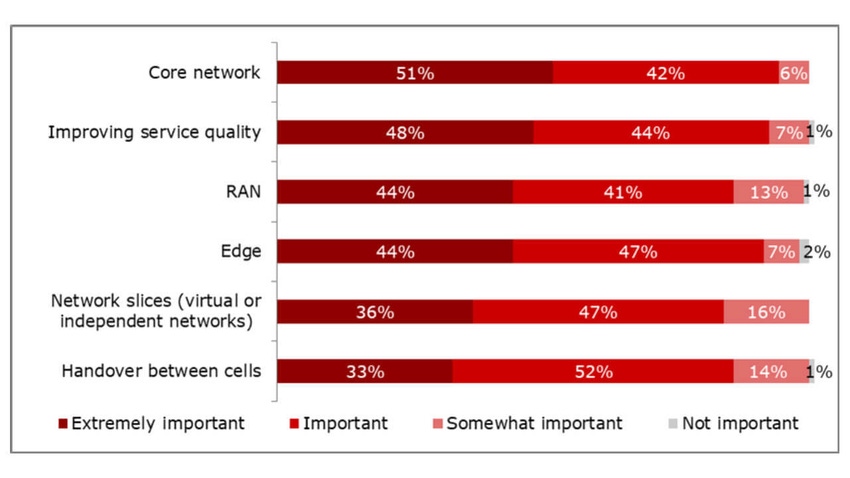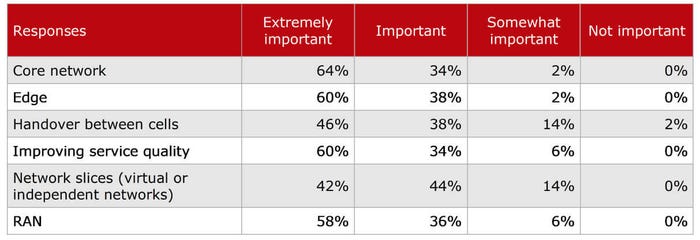5G assurance: Multi-domain monitoring and the indelible impact of automation
Heavy Reading's 5G Orchestration and Service Assurance Market Leadership Program (MLP) survey results indicate that multi-domain monitoring requirements and the need to embrace automation are driving the preference to replace existing assurance platforms.

Although the deployment cycle for the 5G RAN started in 2019, many service providers are only now focusing on the delivery of 5G advanced services — even some four years later. There are several reasons for this timeline, including the decision by several service providers to initially pair their 5G RAN buildout with their 4G core. But today, with the 5G core being paired with the 5G RAN, the end-to-end multi-domain service delivery opportunity is moving to the commercial realm.
While this constitutes a vital step in the 5G journey, there are a number of preparatory steps that service providers must undertake to successfully complete the process. This includes executing a 5G assurance strategy, which is crucial for billing, service provisioning, monitoring customer experience and ultimately 5G monetization.
Looking for detailed insight into the assurance implications, Heavy Reading developed and launched the 5G Orchestration and Service Assurance Market Leadership Program (MLP) with project partners Juniper Networks and RADCOM. The survey, which was fielded in March of this year, attracted 107–108 mobile service providers from around the world. This second blog presents several of the key 5G-related assurance implications of the survey.
5G monitoring requirements
In theory, the complexity of 5G cloud native services will result in the need for a broader multi-domain monitoring approach to ensure that end-to-end service service-level agreement (SLA) targets are met. Heavy Reading's survey results validated this theory.
Based on the "extremely important" inputs below, service providers confirm that a diverse range of network areas must be monitored. Of these, the top areas of focus include monitoring the core network (51%) and improving service quality (48%), as well as monitoring the RAN and edge (both 44%). Secondary but still important monitoring areas encompass monitoring network slices (36%) and handover between cells (33%). Overall, it is clear that service providers believe a successful assurance strategy must support advanced multi-domain monitoring capabilities.
How important is it to monitor the following 5G network areas/capabilities?
To understand the extent to which service provider size had an impact on the data trends, the survey results were filtered utilizing two groups: Tier 1 service providers (those with $1bn or greater in annual revenue) and Tier 2/3 service providers (those with less than $1bn in annual revenue).
In this case, while the core network attained the greatest level of "extremely important" input in both groups (Tier 1 = 64% vs. Tier 2/3 = 40%), there are several differences. First, the data range of "extremely important" inputs from Tier 1 service providers for all the capabilities shown below is greater (42–64%) compared to the data range of 21–40% for Tier 2/3 service providers. The latter group tended to relate to the "important" category (46–65%) for these same capabilities. Second, the edge is a lower priority for Tier 2/3 service providers ("extremely important": Tier 1 = 60% vs. Tier 2/3 = 30%).
Still, while Tier 1 service providers may be more concerned about monitoring complexity, the very low response rate of "somewhat important" and "not important" responses from Tier 2/3 service providers confirms that multi-domain monitoring is an area of concern for service providers of all sizes.
How important is it to monitor the following 5G network areas/capabilities?
Tier 1 (n=50)

(Source: Heavy Reading)
Tier 2/3 (n=57)

(Source: Heavy Reading)
5G assurance platform strategies
The impact of adopting this multi-domain monitoring approach has several assurance implications. These include whether to deploy a 5G-enabled orchestration platform or evolve an existing 4G platform.
The survey research captured the preference for the new platform option. As illustrated below, 54% support the replacement strategy (replace within 12 months [21%] or replace within 24 months [33%]).
This leaves 34% of respondents that plan to evolve their existing assurance platform and 11% who do not know what approach their company plans to adopt.
Are you planning on replacing your service assurance solution to support 5G services?

(Source: Heavy Reading)
The impact of automation on assurance
Heavy Reading believes several factors are driving the preference to replace existing assurance platforms. This includes the multi-domain monitoring requirements documented above, as well as the need to embrace automation to ensure that assurance platforms can meet stringent 5G service performance tolerances.
The requirement to embrace automation enables a shift from manual processes to artificial intelligence (AI)-based processes that are much better equipped than humans to react in real time. As captured below, service providers believe that AI will play a crucial role in numerous 5G use cases.
Of these, based on "extremely important" inputs, the top three use cases are enhancing the customer experience (49%), improving service quality (44%) and automatic detection of network anomalies (41%). Automating root cause analysis to support edge and public and private cloud orchestration (39%) is not far behind.
Although Heavy Reading anticipated that AI would be strongly endorsed on a multi-domain network level to facilitate network anomaly detection and root cause analysis, the top ranking of the linkage of AI to customer experience was unexpected.
The key takeaway here is many survey respondents believe that the automation of network operations and service quality are not mutually exclusive. Rather, automation is a complementary capability that will improve both network and customer experience metrics.
How important is it to utilize AI for the following 5G use cases?

(Source: Heavy Reading)
The multi-domain journey
To ensure they succeed in the 5G era, many service providers are focusing on the multi-domain assurance requirements that will be vital to meeting service performance targets. This journey is driving many of these same providers to deploy a new 5G assurance platform. Additionally, Heavy Reading's research reveals that automation is having an indelible impact on service providers' 5G customer experience-centric monetization strategies.
Looking for more information?
Check out this archived Light Reading webinar: 5G Orchestration and Service Assurance Operator Survey: Priorities and Platforms
Access the white paper: 5G Orchestration and Service Assurance: A 2023 Heavy Reading Survey
This blog is sponsored by RADCOM.
About the Author(s)
You May Also Like












